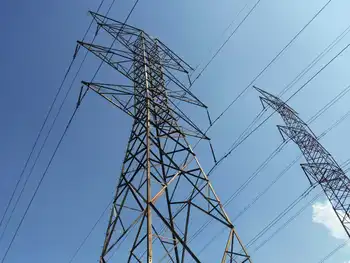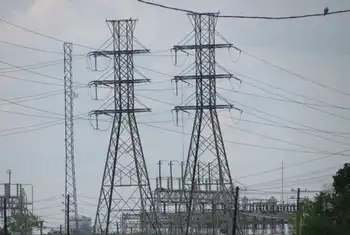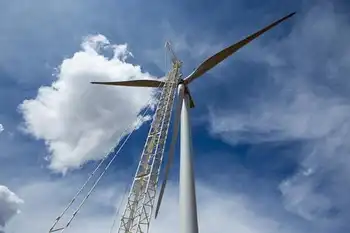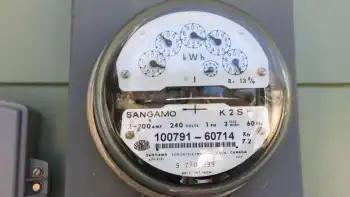Power Bills Soar As Electric Deregulation Fails to Live Up to Its Promises
Her electric bill, which used to be about $800 a month, has jumped to $1,800. She's shut down a large freezer of frozen treats and now closes the store an hour early to cut costs but fears she still may have to raise prices and lay off some workers.
"I'm just trying to figure any way that I can right now to keep my business afloat," Dorchincez said. "My life is at stake here."
The cause of her distress is a common problem: the failure of deregulation to deliver its promise of lower electricity prices. In many states, it's had the opposite effect with sharply higher rates — 72 percent in Maryland, up to 50 percent in Illinois.
Not one of the 16 states — plus the District of Columbia — that have pushed forward with deregulation since the late 1990s can call it a success. In fact, consumers in those states fared worse than residents in states that stuck with a policy of regulating their power industries.
An Associated Press (AP) analysis of federal data shows consumers in the 17 deregulated areas paid an average of 30 percent more for power in 2006 than their counterparts in regulated states. That's up from a 24 percent gap in 1990.
The idea was to move from a monopoly situation to robust competition for electric customers, with backers promising potentially lower rates in state after state.
"We are good at taking money out of people's pockets, but seldom can somebody rise on the floor and say we are going to save people billions over a specific course of time," Illinois state Sen. William Mahar, a lead proponent of electric deregulation, said when his chamber passed a deregulation bill in 1997.
But competition, especially for residential and small business customers, rarely emerged.
Utilities say markets are still adjusting to many years of artificially low rates that drove potential competitors away. They point to states like Illinois, where rate caps just recently were lifted and where there already is talk of reinstating them.
Consumer groups, however, say deregulation has had a chance to prove itself. In Texas, for example, competition did develop after rate caps ended — but the energy prices remained higher.
The AP analysis was based on the average electric rate that residential consumers paid each year from 1990 to 2006, according to numbers provided by the U.S. Department of Energy. Numerical and percentage changes in utility rates of both deregulated and regulated states were compared.
The analysis found more than a widening price discrepancy. Consumers in deregulated states also have suffered from bigger price swings, as rate caps in place when deregulation began in the late 1990s were lifted in the last couple of years.
Now those states' lawmakers are scrambling to figure out how to provide short-term relief for consumers while coming up with a long-term approach to get lower and more stabilized prices. Ideas range from continued rate freezes — vehemently fought by utilities — to re-regulation of the industry.
"We said back then it was a raw deal for consumers. We now know it was a raw deal for consumers," said Johanna Neumann of Maryland Public Interest Research Group.
But an industry official argues that such comparisons don't adequately show the peaks and valleys in rates during that time, and among individual states. And utility executives say that over the last decade, rates in deregulated and regulated states have generally increased at similar levels, thanks largely to sharp spikes in fuel costs — not deregulation.
John Shelk, president of the Electrical Power Supply Association trade group based in Washington, D.C., says all states have seen large rate increases in the last decade, largely because of the increased price of natural gas and building power plants. The average U.S. price for natural gas used by the electric power sector tripled from $2.76 per million Btus in 1997 to $8.21 per thousand cubic feet in 2005, a peak year for natural gas prices, according to federal energy statistics. Prices dropped slightly in 2006 but are projected to rise again over the next two years.
Utility officials say natural gas prices, environmental regulations, property taxes, the cost of building nuclear plants and other expenses in states that deregulated had already driven prices higher than in other states.
But years after many states deregulated, the rate gap between those states and regulated states had widened even more, experts and consumers advocates say, because consumers in deregulated states were left paying market prices — even though in many cases no competitive market existed.
"Now they're trying to come to grips with the reality that the market isn't working as well as they thought it would," Ken Rose, a senior fellow with the Institute of Public Utilities at Michigan State University, says of decision-makers in deregulated states.
Shelk says consumers in states like Illinois are seeing "sticker shock" because their rates were artificially low for years, and that forced a large increase to get back to market prices when rate caps were lifted.
"It's kind of like pulling the Band-Aid off," Shelk said. "I think you can fault the design that said you can roll these rates back and freeze them."
He predicts that the rate gap between deregulated and regulated states will shrink in the next few years when regulated states in the Southeast that rely heavily on coal-fueled power see prices soar under heavier environmental restrictions.
"It's so easy to focus only on the here and now ... and draw the wrong conclusions, which is 'Oh, gee, we're going to be better off regulating,' because we're not," Shelk said.
Shelk also contends that deregulation has been successful in states like Texas because, despite price jumps there, the competition has kept rates lower than they would have been under monopoly conditions, and still has produced a more predictable market for utilities and customers.
Exelon executive vice president Betsy Moler said rates in all states, regardless of their regulatory structure, have soared about 34 percent since 1996, mirroring fuel cost increases. That should overshadow critics' blame of deregulation, she argues.
"It's really not about deregulation," Moler said. "It's all about the cost of fuel."
Yet the last decade saw extended rate freezes in many states, and more recent data shows a returning gap between regulated and deregulated states once those freezes end.
Illinois' deregulation plan froze rates for 10 years. The freeze ended in January and rates immediately soared 30 percent to 50 percent for millions of people. Some have seen their bills double and even triple.
In Carterville in southern Illinois, Dorothy Petersen is looking for a second job to supplement her $1,000-a-month income after seeing her electric bill more than double, to $450. A single mother with four kids — all with health or development problems — Petersen is heating only the kids' rooms and turning off lights.
"If it was just me, it wouldn't matter. There's things I could do," Petersen said. "But I have these kids."
Maryland faced a 72 percent rate increase last summer, until lawmakers stepped in and cut the initial jump to 15 percent to 25 percent. Now consumers must pay the remainder this summer, and advocates fear problems for the most vulnerable citizens — seniors, low-income households, working families.
Texas residents like recent retiree Bill Sebenoler of Arlington have more utility choices under deregulation, but that hasn't kept prices down. Sebenoler said his bill reached nearly $500 in September 2006, up 82 percent from a year earlier.
"It's irritating as hell, and that money would go somewhere else," Sebenoler said. "Something ain't working right."
Consumers in Delaware, Rhode Island and Connecticut have seen rate spikes in recent years, putting their rates among the nation's highest. That led to more than 25,000 electricity shutoffs in Rhode Island last year, a new state record, said Henry Shelton of the George Wiley Center advocacy group.
In Montana, Ed Eaton says he and other consumers have seen a 40 percent increase since rate caps were lifted in 2001. Eaton said he's cut expenses by eating more canned tuna for meals.
"I probably could have turned this into a weight loss program and benefited," said Eaton, a former state employee.
Deregulation was sold to state decision-makers as a boon for everyone. The thinking was that by separating electricity generators from distributors and letting the market determine prices, competition would thrive and customers would benefit from better choices and lower rates.
Experts and advocates acknowledge that some consumers have seen those benefits.
In some states, large industrial and business users have seen increased competition, giving them the ability to switch to other utilities. Residential users in states such as Texas also have a few more options.
But besides a small group of commercial users, consumers in deregulated states have seen a disappointing result.
Instead of competition producing lower rates, the choices are between high or higher prices. In some states such as Illinois, residents have no choice but to get their power from one or two mega-utilities, who are passing on soaring costs for the power they're buying.
ComEd, for example, has about 3.3 million residential customers in and around Chicago, while Ameren covers 1.2 million customers in central and southern Illinois. Combined, they control about 98 percent of Illinois' investor-owned market, according to the Illinois Commerce Commission. "In terms of price, you can't see the customers benefiting," said Rose, the Michigan utility expert.
Utilities say they're not to blame for consumers' higher costs.
Since they no longer produce their own power, the utilities in Illinois, for example, say they've simply passed on their higher purchasing costs to consumers, resulting in the higher rates. While some of the generation companies have ownership ties to the retail utilities like ComEd and Ameren, Illinois regulators note they have strict rules to ensure affiliates do not trade information or conspire on pricing.
The utilities also note that they warned consumers last year about the pending increases and offered assistance through some financial aid and a phase-in plan.
"I think we've done all the things we know how to do as a utility to soften the transition into the new rates," ComEd CEO Frank Clark said in February.
The poster child of deregulation failure is California, which saw a combination of skyrocketing rates and service problems before scrapping the experiment. Some other states such as Virginia tried deregulation but rejected it after it didn't provide lower rates.
States that did embrace deregulation now are trying to figure out what to do next.
In Illinois, lawmakers are debating rolling back rates to 2006 levels and freezing them for up to three years. They're also negotiating with the utilities for millions of dollars in rate rebates for consumers hit hardest by the increases.
Re-regulating the market is a popular idea. State-owned utilities are another possibility.
Utilities and their advocates are urging caution for states considering dumping deregulation. They say competition couldn't thrive under rate caps but should now that many of those caps have been lifted and the market is determining rates.
The utilities also warn that any further rate rollbacks and caps could create financial disaster, sending them quickly into bankruptcy if they're forced to buy power at higher costs than they can recoup from customers. Even so, consumers like Dorchincez are looking for relief now.
In addition to the problems at her grocery store, Dorchincez got hit at home, where her bill jumped from $230 to $700. She's looking to cut back wherever she can — turning down the store's thermostat, shutting off other freezers and soda machines, turning off lights in the parking lot.
Consumer advocates say states should be able to see the folly that deregulation created and should act soon to prevent more consumer suffering.
"It's never going to work. There's never going to be robust competition created," said David Hughes of Citizen Power, an advocacy group covering Pennsylvania and Ohio. "It just doesn't lend itself to the volatility of the marketplace."
Related News

European responses to Covid-19 accelerate electricity system transition by a decade - Wartsila
LONDON - Coal based power generation has fallen by over a quarter (25.5%) across the European Union (EU) and United Kingdom (UK) in the first three months of 2020, compared to 2019, as a result of the response to Covid-19, with renewable energy reaching a 43% share, according to new analysis by the technology group Wärtsilä.
The impact is even more stark in the last month, with coal generation collapsing by almost one third (29%) between March 10 and April 10 compared to the same period in 2019, making up only 12% of total EU and UK generation. By contrast, renewables…





